Hello Meira,
I am writing in because I have noticed that you talk a lot about positive reinforcement in dog training, and I get the impression that you don’t believe in prong or choke collars. With my other dogs, I have always used choke collars, and I also used a prong collar on a very strong, large dog that I had, who would bark and lunge at other dogs when on walks. If I didn’t have that prong collar on him, I don’t think that I could have controlled him. I am now getting another dog soon, and I am wondering what would be best for me and my dog. I had always trained my dogs with these kinds of collars, but now I am wondering if I should still keep doing this. I have also heard some people say that they are illegal now. So many people are saying so many different things, and it’s just so confusing. What would you advise?
Eileen
Hello Eileen,
Thanks for writing in with such a great question! I totally understand your apprehension, and your concerns, especially since prong and shock collars are now in fact illegal in the province of Quebec, if they cause undue harm to the animal wearing it.
I can also totally relate to you, how you’re questioning what will be best for you and your new dog, as I am in fact a crossover trainer, meaning that I used to use choke collars, and at times even prong collars when training dogs. If you worked with me about 9 – 10 years ago, the chances were high that I might have been using a choke collar when training.
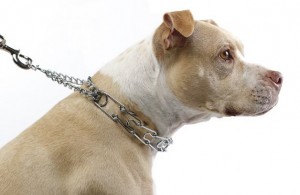
Thankfully, I felt it was important to keep learning, and to keep sharpening my skills as a trainer. And the more I learned, the more I learned that these types of tools were not necessary to teach a dog to obey me, or to learn new behaviors. This was my beginning to becoming a cross over trainer.
Today in the training world, there are pretty much two camps. Those who believe in positive reinforcement training, and those who believe in compulsion training, or Pack Theory/Dominance Theory training. Some people will argue that these are two philosophies, and differing of opinion. And while they may be differing in opinion, opinions don’t really matter all that much when it comes to science. And there is a science to learning. There is a law that governs learning, and it’s occurring whether someone believes in it or not.
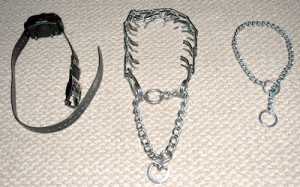
Suffice to say that I am now a positive reinforcement trainer. I no longer use choke, prong or other aversive training tools when I am working with dogs to either teach them new behaviors, such as new obedience behaviors, or even when I am working with dogs, modifying existing behaviors, which includes serious behavioral problems, including aggression. These types of tools aren’t required, and can even make things worse.
Science has shown, time and time again, that using these types of tools carries a big risk of fallout. Science has also shown that painful tools such as these do not give long lasting results. They may suppress an unwanted behavior for a time, but they do not deal with the underlying emotion that caused the unwanted behavior in the first place. Which means that the behavior eventually comes back, either when the dog becomes too stressed, is over threshold, and often times, once the punishment, or tool is no longer used.
When you modify behavior in a dog, you are trying to either extinguish behaviors (usually, unwanted behavior), or to elicit wanted behaviors. To stop a behavior, you use the punishment quadrants. To elicit behavior, you use the reinforcement quadrants. (Science says this, not just me.)
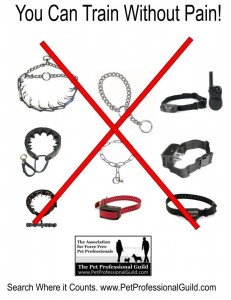
Each quadrant has a mathematical component of adding or removing wanted vs. unwanted stimuli. There is positive punishment, where you add an unwanted stimulus to stop a behavior. There is then negative punishment, where you remove a wanted stimulus to stop a behavior. In reinforcement, you again add or remove a wanted or unwanted stimulus to elicit behavior. With positive reinforcement you add a desired stimulus, and with negative reinforcement, you remove an undesired stimulus.
Positive punishment means that you add (the math part) something the dog doesn’t like, and will work to avoid, to stop the unwanted behavior. It doesn’t mean that the punishment is good….it means you are adding something to the equation. You are adding something the dog doesn’t like, or will work to avoid. This can be a leash correction, a leash pop, a yank, a choke, prong or electric collar, a yell, a hard stare, a kick….anything that the dog wouldn’t like. And keep in mind that it’s the dog who decides what it doesn’t like, not us.
For positive punishment to work correctly, the punishment needs to either scare or hurt the dog enough within only one or two tries so that the dog never ever tries the unwanted behavior again. If done correctly, after that first or second try, the dogs’ mind will be changed, and the punishment will never need to be used again. If done properly, it does work to stop the unwanted behavior. But the question of it being done properly is a serious one. As are the ethics with using it in the first place.
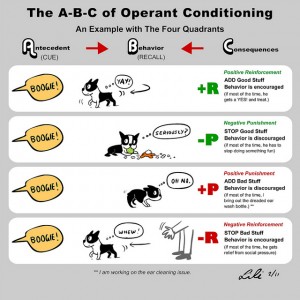
The problem here is that it’s very difficult to tell what would be hard enough to make the dog stop. If you go too hard, you can just shut the dog down, into a learned state of helplessness. (What you often see when someone tells you that a dog is in a calm, submissive state.) You can create such a negative association with the trigger, the handler, the environment, and/or whatever is around, that you ruin the dog. Thankfully, this doesn’t happen that often. But that creates a whole other problem, that can even be worse.
If you don’t scare or hurt the dog enough within the first two tries to extinguish the unwanted behavior, then you need to keep giving corrections until the dog heeds the corrections. And this becomes problematic as the dog is now becoming sensitized to the correction. And once the dog becomes sensitized to the correction, you have to use harsher and harsher corrections. And the biggest problem is that this very act of sensitizing the dog to the correction, actually strengthens the unwanted behavior that we have been trying to extinguish in the first place!
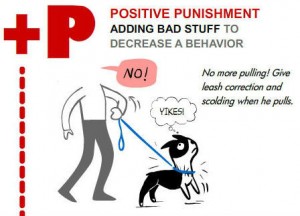
(Sensitization is a non-associative learning process in which repeated administrations of a stimulus results in the progressive amplification of a response.)
Another issue is that science has shown again that using painful tools, force or corrections in treating aggression just begets more aggression.
Over 95% of aggression is rooted in fear. There are really very few dogs with idiopathic aggression. Using painful methods to help a fearful dog does not help him overcome his fear. And keep in mind that fear is not just a dog who cowers. Fear can be seen in any distance increasing behavior. (Which is what most aggressive behavior is.) It also makes no sense to give corrections to a dog who is just obeying his instincts, especially ones that we’ve honed over thousands of years, as with a dog who is displaying predatory aggression. Much more helpful, and will also give you much longer lasting results would be to teach the dog a new alternative behavior instead of the unwanted behavior.
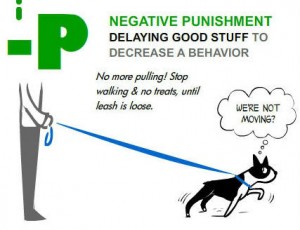
Science has shown that what works best with aggression and fearful issues is a combination of both desensitization and counter conditioning. You use DS/CC in response to the trigger that makes the dog behave in the unwanted manner.
In a nutshell, if you are to use painful punishment based corrections properly, and effectively, you need a clear understanding of canine learning theory, a great understanding of canine body language, and perfect timing and mechanics.
But if you have all of those attributes, you don’t need to use painful corrections at all in the first place.
So, in answer to your initial question….no, I don’t believe that using a choke collar, or a prong collar would be the way to go with your new dog. Instead I would suggest using a regular flat collar. If your dog has a very narrow head, that is slimmer than his neck (such as with a Greyhound, or at times a Doberman), then I would suggest a martingale collar. If you have problems with a dog who is a strong puller, I would suggest a front clip body harness. If you find you still need help, then I would suggest finding a positive reinforcement trainer in your area who can help you teach you how to apply loose leash walking skills to your dog.
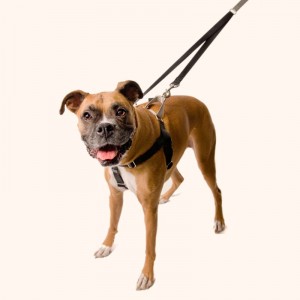
Remember, it’s never too early to start working with, and/or training your dog. Because your dog is learning, whether you think you’re training him or not.
Good luck and happy training!
Meira
 Montreal Dog Blog Montreal's Online Dog Park
Montreal Dog Blog Montreal's Online Dog Park



